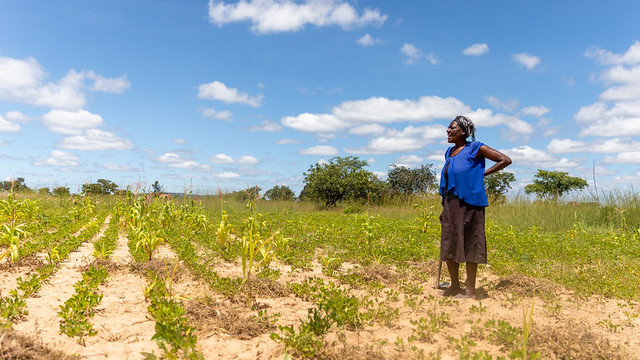Adaptation's turning point: can we set global targets in time for COP28?
Next week is the final workshop for thrashing out the framework for the Global Goal on Adaptation before the detail is decided at the UN climate negotiations in Dubai (COP28). The goal’s framework will shape the future of action on adaptation. Lina Yassin and Binyam Gebreyes describe the process so far and discuss what’s at stake



Over 100 people lost their lives as wildfire devastated the Maui community of Lahaina in Hawaii in August 2023. As climate-related disasters become more frequent and get worse, any action being proposed in adaptation debates must significantly impact realities on the ground (Photo: State Farm, via Flickr, CC BY 2.0)
The climate change narrative has long been skewed towards mitigation; adaptation has often been sidelined and overshadowed by the heavy focus on reducing emissions.
And so establishing the Global Goal on Adaptation (GGA) was one of the Paris Agreement’s crowning achievements.
Pushed for hard by developing countries and in particular the African Group of Negotiators (AGN), this ambitious goal marked the first time all countries agreed the need for collective action on adaptation – to enhance adaptive capacity, strengthen resilience and reduce vulnerability to climate change.
Yet after reaching this milestone in Paris, progress on clarifying specifics of the GGA was painfully slow – no agreed process, no targets, and no pathway towards achieving the goal. Adaptation was back to being sidelined.
The tide turned at COP26 in Glasgow with establishment of the Glasgow Sharm El-Sheikh work programme (GlaSS) on the GGA. Spanning eight workshops, this two-year programme was designed to enhance the world’s understanding of the GGA, to turn it into concrete action and to review its progress.
But after a year of workshops, it became clear that the GGA process needed a structured approach. Thus, at COP27 in Sharm El-Sheikh, parties agreed to establish a framework to guide the global approach to climate adaptation and ensure the GGA would be achieved.
Designing the GGA framework
With parties agreeing to adopt the framework at COP28, the timeframe was tight – and now the clock is ticking.
The outcomes of the eight GGA workshops will be fundamental in informing decisions on the framework, to be taken forward to COP28. Running since June 2022, these workshops are open to all countries as well as civil society organisations and adaptation experts.
Post-COP27, the workshops turned their attention to designing the framework, where countries could voice their perspectives on its structure and content.
Tension: targets or not?
The first two workshops of the year didn’t yield much progress or clarity. It was the climate negotiations in Bonn in June when tensions began to rise.
A major sticking point in Bonn was whether the framework should integrate specific adaptation targets – such as all developing countries being covered by early warning systems or a target number of people achieving food security by a specific year.
Developed nations argued that enhancing adaptation efforts and achieving the GGA is about more than just setting targets; they emphasised that the framework needed to support international collaborations for adaptation, actively engage the private sector, and capitalise on pre-existing adaptation frameworks within the UN climate convention.
But for developing nations, incorporating targets within the framework was non-negotiable – clear targets are needed to put the framework into practice, and for achieving tangible outcomes on the ground.
Amid these contrasting perspectives, the Bonn negotiations were tense. It wasn't until the final moments that a consensus emerged. Targets were referenced in the outcome text and while the reference was only subtle – the mention of targets appears in the footnotes – this nonetheless means that targets can be put forward for consideration in the framework's ultimate structure.
EU changes course
The outcome of the Bonn negotiations set the stage for targets-focused discussions at the 7th GGA workshop, hosted last month in the vibrant embrace of Buenos Aires.
Various developing countries groups presented their desired targets to be included in the final framework.
For developed countries, the European Union negotiating bloc shook things up by introducing their target proposals at the workshop's opening session. This move acted as a catalyst, encouraging other developed nations to contemplate their stance on whether the framework should include targets, or to evaluate the varying proposals on the table.
However, while the EU introducing targets signified progress and willingness from developed countries for a rethink, the targets proposed were purely based on adaptation processes. This approach did not align with the views of certain developing country groups.
The Least Developed Countries (LDC) Group, the AGN, and the Alliance of Small Island States (AOSIS) repeatedly highlighted their concerns that targets focusing solely on adaptation processes, such as setting a deadline for all countries to finalise their National Adaptation Plans, wouldn't significantly impact realities on the ground.
Many LDCs have completed their National Adaptation Plans yet still face significant challenges in implementing these plans. This underscores that the core challenges extend beyond these procedural steps.
At present, there's no unified stance on which targets should be in the framework, even within developing countries. However, a consensus emerged on one front: irrespective of the finalised targets, the framework’s effectiveness hinges on ensuring adequate finance, capacity building and technology transfer in its execution.
The final countdown
The Buenos Aires workshop was a sign of hope, marking the first productive dialogue on the GGA framework's structure. It fostered collaborative discussions, enabling parties to find common ground while addressing differences in a setting that was outside of the formal negotiations.
Ahead of next week’s final GGA workshop, the looming question is whether parties and observers will be able to reach a consensus on the framework's structure and targets.
This three-day long workshop in Botswana must be about compromise and finding middle ground: the current list of over 30 targets needs to be narrowed down significantly, countries must focus on finalising the structure of the framework as well as outlining the work to come post-COP28, once the framework has been adopted.
The discussion and conclusions reached in Botswana will guide parties’ negotiations in Dubai. If global targets for adaptation are agreed, this would send strong political signals to the world that adaptation is finally on equal footing with mitigation.
What’s at stake?
As the climate crisis intensifies, the importance of a robust GGA framework becomes ever clearer. With every delayed adaptation action, the most vulnerable countries continue to experience more loss and damage.
Progress on the GGA to date signifies global unity in addressing climate adaptation. But willingness alone is not enough – what’s needed are tangible results.
In this final workshop, it is not just a framework that parties are shaping but the very future of climate adaptation action.
Getting a robust framework is our big chance of achieving levels of adaptation the world needs to prevent more irreparable loss and damage.
COP28 must then be the stage where these collective aspirations converge into a cohesive and actionable blueprint for a more resilient world.




